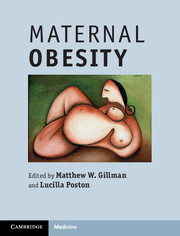Book contents
- Frontmatter
- Contents
- Contributors
- Preface
- Section 1 Trends and determinants of obesity in women of reproductive age
- 1 Demography of obesity
- 2 Determinants of obesity
- 3 Obesity and fertility
- Section 2 Pregnancy outcome
- Section 3 Long-term consequences
- Section 4 Interventions
- Section 5 Management and policy
- Index
- Plate Section
- References
3 - Obesity and fertility
from Section 1 - Trends and determinants of obesity in women of reproductive age
Published online by Cambridge University Press: 05 August 2012
- Frontmatter
- Contents
- Contributors
- Preface
- Section 1 Trends and determinants of obesity in women of reproductive age
- 1 Demography of obesity
- 2 Determinants of obesity
- 3 Obesity and fertility
- Section 2 Pregnancy outcome
- Section 3 Long-term consequences
- Section 4 Interventions
- Section 5 Management and policy
- Index
- Plate Section
- References
Summary
Introduction
The role of body weight on human reproductive function and fertility has received considerable attention in the medical literature. A multitude of studies have documented the effects of underweight on fertility in a variety of populations. These include studies of seasonal patterns in fertility rates associated with food availability in agricultural societies and studies documenting menstrual cycle abnormalities among lean women in Western populations either engaging in extremely demanding physical activities (such as competitive sports or professional ballet) or suffering from eating disorders [1,2]. Cumulatively, these data led to the identification that the adipose tissue plays a critical role in regulating female reproductive function. Frish was the first to propose that a certain minimum amount of adipose tissue was necessary for the initiation and maintenance of menstrual function and fertility [2]. It is currently known that the effects of undernutrition on infertility are caused by hypothalamic dysfunction and decreased gonadotropin secretion possibly due to decreased signaling of leptin to the hypothalamus [3].
The opposite end of the body weight spectrum has only recently gained attention on its potential role on fertility due in part to the rapidly increasing prevalence of overweight and obesity worldwide. Even though polycystic ovary syndrome (PCOS), the most common cause of anovulation and a frequent cause of infertility, was first described in 1935 [4] and that some clinicians might have been aware of a connection between obesity and lower chances of conception as early as the fourteenth century [5], systematic investigations of the role of overweight and obesity did not take place until the 1980s and the biological mechanisms underlying this association are still being disentangled.
Keywords
- Type
- Chapter
- Information
- Maternal Obesity , pp. 20 - 34Publisher: Cambridge University PressPrint publication year: 2012

